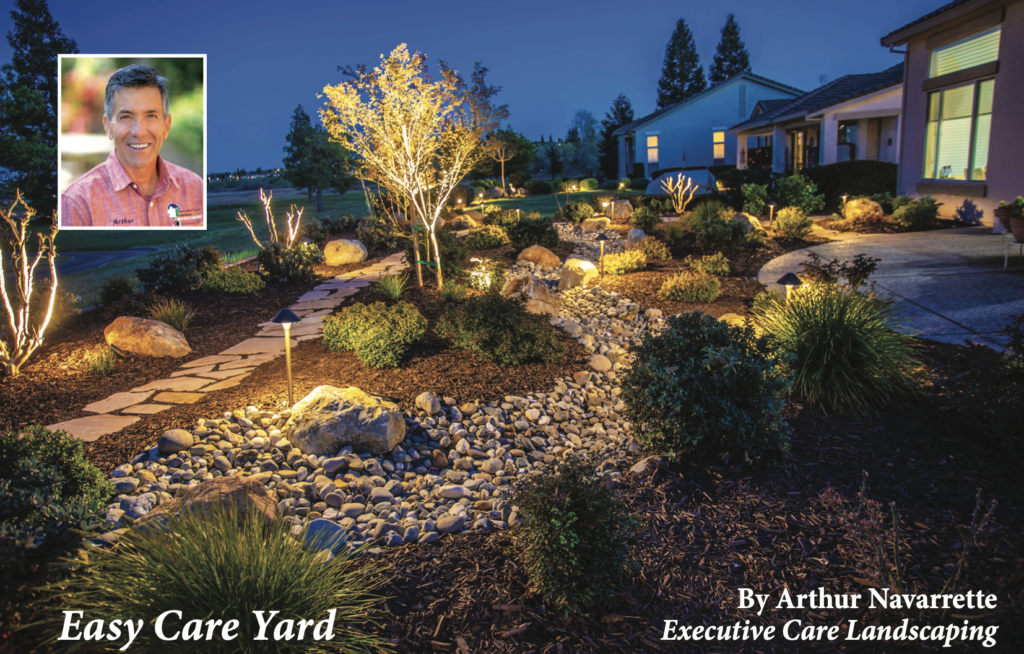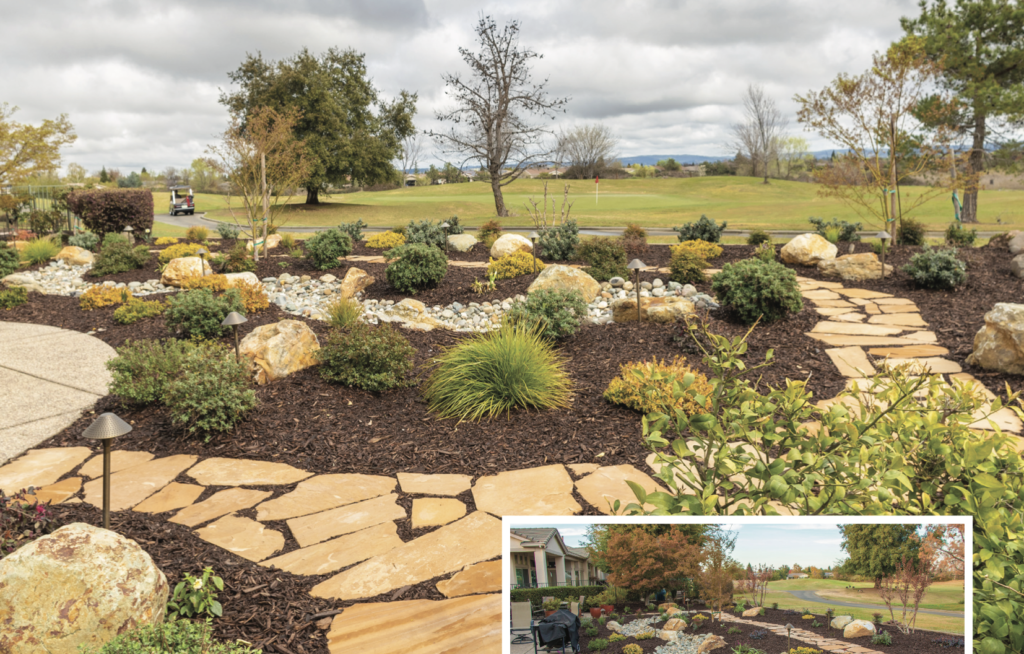

Welcome to our May article. I hope you are well. It seems that Covid is becoming a thing of the past. I see more lips and smiles, and I see many more cars out on the road. It was only two years ago that I and a few contractors were the only ones out. It definitely was different, and a little eerie. Though traffic is not fun for anyone, I would rather see traffic than not. I now have a whole new attitude towards traffic. It means things are getting back to normal, and that’s good. Now let’s talk about this month’s landscape.
This style of a yard is not for everyone, especially if you have kids. With kids, we would do a whole different type of landscape. However, if you are single, have kids almost grown, or are retired and done with all the yardwork, you may want to consider this style of landscape. It is colorful, drought smart, very low maintenance and yet it is still inviting. Our featured landscape. We completed the project in October 2020 and the “before” picture is really the just completed picture. Though it is still a young landscape (about a year if you exclude the last two winter months, I want to set expectations for what a new landscape should look like, as well as a periods throughout the years to watch it mature. I will probably revisit it in about 1 to 2 years.
Prior to what you see now, this was the typical landscape. It was all lawn with plants along the border. The job is in Sun City Lincoln, and it is for a client who enjoys looking out into his landscape and doing some light trimming while enjoying the sun. Last year he was in a boot due to foot surgery. He could not mow, and with the prior landscape, he would have had to hire someone. He enjoys sitting at his outdoor table enjoying a cup
of coffee with a friend or doing some personal reading. This type of yard does not tie you down. If a friend calls up and says let’s go out, this style of yard has its benefits. It is not great for children unless you have a park or a school close by.
Developing the concept came from a few questions I asked John. I also listened to his wants. By the time one is living in a retirement community, they normally have a pretty good idea of what they want. This made it easy to come up with a concept that would meet his needs. I enjoy dry stream beds for several reasons. They reduce plant maintenance, bring in a high-end view of the landscape (when done correctly), and give an added dimension of what is in nature, though in nature it has water. Additionally, it looks great at night with the proper placement of night lights. I see so many dry stream beds that look like nothing more than cobble placed on the ground in a linear pattern. There is no depth or real design, and I like incorporating boulders into the stream bed. We try to get as close to nature as possible, just without the water. A real stream bed adds another dimension of sound and beauty, but the maintenance and added cost (on top of the cost of the landscape) makes it undesirable for most of our clients. “Make believe” is just fine.
As most of you know, everything about the landscape leading up to the plants is important. Preparing the ground with amendments, mounding for dimension and depth (no flat landscapes), boulders, and dry stream are all part of a well- executed landscape. However, if the selection of plants fails, the whole job fails. I have seen other landscapers try to emulate our work. It’s easy to tell that it’s not our work, but it becomes really
apparent from the plant selection. This is where people wanting landscapes need to wise up a bit. Plants are so different, both in appearance, growth rate and size, sun preference, irrigation needs etc. Some look good together and others do not. Some are high maintenance, and some are not. Many landscapers do not know these differences, so it is up to the homeowner to be well-studied. Spending time at Green Acres, reading and researching plant height, water needs, sun light etc., is critical to ensure that you get a good job. I hate saying this to you, but it should be up to the landscaper to know his trade, not the homeowner. It’s apparent that this is not the case, and as much as we would like to help everyone, it is not realistic.
Night lights are amazing. Good ones are expensive, but they take a landscape to A+++. There is a peace and tranquility they give, and if you are into entertaining, they extend the evening hours. However, there is a little study that goes behind them. We use solid brass because it adds class, as opposed to aluminum fixtures that are powder coated and fade. However, I would use them if that is all my budget could afford, and then upgrade at a later date. Good fixtures are attractive, but it is more the effect of the light that we are wanting. I have lived by the rule that there is nothing I will add to the landscape if it does not help take the landscape to the next level. This is why we use brass fixtures.
Call for a FREE Consultation*
*Free consultation given within local area only. Nominal charge may apply for travel outside of local work area. Call for details. CL#804681
Finally, gardeners I hope you have your garden beds ready. It’s time to plant. Water frequently, keep the soil moist but not wet. After a couple weeks, increase your watering times to deepen the roots, but water less frequently. At this point it’s okay to let the surface dry out between watering. The goal is to develop deep roots and prepare the crops for the heat of summer. Be liberal with your fertilizer, as if you love salt with your food, but use an organic fertilizer with a 5-5-5 ratio with mycorrhizae (mycorrhizae is a must). I like to add it 1 week before the crops go in, tilling it under with a thorough watering to dissolve it. Because it is organic, it requires the soil biology to break it down and make it available for the plants.
Until next time….
Thank you for reading. Arthur
